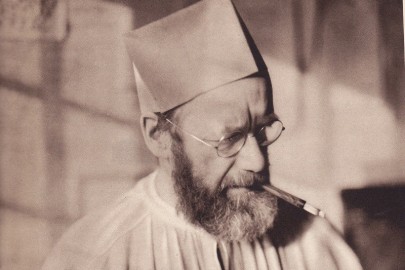
Today we recall a Christian who threw himself to the lions.
It is a very terrible thing to be “framed up” and cruelly punished when one is entirely innocent. … I always call mine a clerical Dreyfus case. Still, I feel sure things will eventually right themselves, for “though the Mills of God grind slowly, they grind exceeding sure[sic]”.
Harold Davidson, in a letter to Lady Weigall, 1st January 1937
In 1937 the former Rector of Stiffkey, Harold Davidson, was killed by a lion called Freddie.

The defrocked and disgraced prelate had been appearing in an entertainment in Skegness as Daniel in the Lion’s Den, with Freddie and a lioness called Toto. He would stand in the cage with the somnolent lions and give a little talk to the onlookers about the various injustices which he (Davidson, not Daniel) had suffered, for about ten minutes. On this particular occasion, he tripped on Toto’s tail and Freddie, startled to action, mauled the old man fatally about the neck.
It was not Davidson’s first dismemberment. Five years previously, following his conviction in Consistory Court on various counts of immorality, the Rector had been defrocked in a ceremony in Norwich Cathedral. Ironically it was the emergence of a photograph of Davidson posing with a literally defrocked would-be actress (and daughter of a friend) called Estelle Douglas which finally put the mockers on his defence.

I do not know whether he was present at the ceremony, which can be perfectly well conducted in absentia and unlike cashiering (I find, to my disappointment) does not involve an actual disrobing. It is merely a reading of the judgement of the appropriate authority framed by some prayers and hymns.
Nevertheless, the end of priesthood is a symbolical disrobing of the priest. A priest is a priest by dint of the clothes he (or she) wears. The analogies of enrobing run deep in the spiritual mind. What was the incarnated Christ, after all, if not a spirit-being dressed up in the weeds of humanity? Creation itself was an adornment of matter: twelfth century philosophers, building with gay abandon on some hints of St. Augustine, had developed the complex theory of exornation which explained how creation had taken place in two stages – first the summoning of inform matter (chaos); then the ornamentation of that matter (cosmos = cosmetics).
Of course this was supposed to be a logical, and not a dramatic, distinction; creation stories – whether of the adorning or finger-pointing variety – are for minds less rigorous. Nevertheless, the controlling metaphor both of creation and incarnation was one of investiture. The invisible was made visible by being clothed; a sheet was thrown over the ghost.
And then summarily whipped off again, if you were the Rector of Stiffkey. In the years following his disinvestiture, plain old Harold starred in various threadbare entertainments in Blackpool and Skegness, more or less as himself. To begin with he made appearances fasting in a barrel, a Diogenes of forbearance. Extraordinarily, and inexplicably to us, he drew crowds so vast a public order injunction had to be brought against the impresario of the show.

After that he developed his act to include a tableau vivant of himself in an oven, being prodded with a pitchfork by a sidekick dressed as a devil. And finally he stepped into the lions’ den, with tragicomic consequences.
It seems that the Rector of Stiffkey used to be proverbial. I had not heard of him until I visited Blakeney a few weeks ago, and passed through the village of Stiffkey. My source on that trip, a friend called Timothy Feakins whose powers of recall are admittedly variable, assures me that as late as the 1950s he (the Rector, not Feakins) was sometimes dragged out in double-page spreads in The Express as a paragon of moral turpitude. Davidson’s descendants have subsequently made efforts to show that he was the victim of persecution, originating in local grudges and village suspicions and subsequently amplified by the ponderous investigative machinery of the church and the reverberations of the gutter press.
Like a confused old Lear, however, the extent of his culpability is no longer of central interest. There remains to us only the carnivalesque spectacle of a man fragmenting: the uncloaked priest was no more than a shocking tittle of bit-parts and rumours, self-justification and self-abasement, so that it is difficult to see where persecuted Daniel ends and cigar-smoking Harold begins. Unaccommodated man, we might reflect, is no more but such a poor bare forked animal as Harold Davidson was (“off you lendings! Come, unbutton here [tearing off his clothes]”).










This terrific yarn puts me in mind of Tom Butler, and his immortal line: “I’m the Bishop of Southwark, it’s what I do.”
Ahh the rector of stiffkey, I was going to write about him in a few weeks time but you’ve beaten me to it Toby! Fascinating tragi-comic life and death
Oh, sorry about that. Have to say, I had a suspicion, of sorts – I did a search on the site before I started writing this. Irresistible subject.
I’m sure the title, Rector of Stiffkey, helped with the notoriety. It’s really unimproveable.
Ah, but it is pronounced ‘Stewkey’. No doub to prevent childish titers of the gutter variety.
Yes, had to be, didn’t it? However, I should imagine the readers of those tabloid (or proto-tabloid) spashes sounded it stiff-key in their heads and tittered notwithstanding, just as I will probably continue to do.
The Rector of Stiffkey is alleged to have said, in hospital…
I think Davidson’s death would have been avoided if he’d entered the cage with that heavily starched dog collar in place (Sadly, I suppose defrocking included decollaring). Knackered old Freddie would never have got his incisors through that thing; he would have dislocated his jaw in the attempt.
In the early sixties, I developed a fascination with the lives of the great barristers: Birkett, Marshall Hall, F E Smith and Carson; I raided our local library for everything available on those remarkable men, and as I read your post, Toby, something stirred in my memory: did Birkett have some involvement with Davidson? In H. Montgomery Hyde’s biography of Birkett, he states the following…………………….on second thoughts, I’ll leave it. The return to work on the day after a glorious Bank Holiday is trying enough; who wants another set of bloody traffic lights?
Not that I know of John – his defence team was Jewish, which apparently riled up the Chancellor of the Diocese of Norwich, presiding.
For what it’s worth, Toby, and it might not be a lot, this is Montgomery Hyde’s account:
‘In the same month as Mrs Dampier’s trial, Birkett, through his retainer for Odhams Press was involved in proceedings which made legal history and which were the prelude to a most sensational inquiry before a Consistory Court at the suit of the Bishop of Norwich. The question at issue in the preliminary hearing was whether there could be a contempt of an ecclesiastical court punishable under the ordinary law. The matter arose from the conduct of a clergyman in the Bishop’s diocese, the Rev. Harold Davidson, Rector of the Parish of Stiffkey, Norfolk, who had been accused, among other charges, of immoral conduct on numerous occasions with a prostitute named Rose Ellis.
The Rector, who had a wife and several children, was in the habit of spending his weekdays in London on the pretext of reclaiming prostitutes, returning to his parish only to preach the sermon on Sundays. Information eventually reached the Bishop that Mr Davidson’s pretended interest in prostitutes was merely a cloak for his own amorous activities. It appeared that he had made improper suggestions to a waitress in Walbrook, he had kissed a girl in a Chinese restaurant in Bloomsbury, he had embraced an actress in her nightdress, and for the past eleven years he had been intimately associated with Miss Ellis, although his original pretext for picking her up in Leicester Square was to rescue her from a life of prostitution.
While the charges were pending before the Consistory Court in Norwich, and while the morally delinquent Rector was preaching sermons at Stiffkey, appropriately on the theme of love, Miss Ellis was interviewed by a reporter from the Daily Herald, which was published by Odhams. An article subsequently appeared in that newspaper and was the subject of contempt proceedings. In that article Miss Ellis was reported as having stated that Mr Davidson had been very kind to her on numerous occasions, that there had never been anything improper in their relations and that she had been bribed by ‘a man and a woman’ whom she had met in a public house and when she was under the influence of eight glasses of port wine to make false charges against the Rector. The latter, not wishing to be outdone by his girl friend in publicity, proceeded to give his version of what had happened in another journal, the Empire News. Proceedings for contempt of court were accordingly instituted against the publishers of both newspapers, as well as against Mr Davidson, before a King’s Bench Divisional Court presided over by the Lord Chief Justice, Lord Hewart.
In apologising on behalf of his clients, Birkett said this was the first time so far as his researches went, ‘and they had been very extensive’, where it had been sought to attach anyone for contempt of a Consistory Court. This kind of contempt differed considerably from, at least to the lay mind, from contempt of the King’s Courts such as Assizes, the Consistory Court’s jurisdiction arising as it did from the Clergy Discipline Act. He could only plead in mitigation that, whatever might be said of the wisdom or prudence of such stories as had appeared, it might be natural for those responsible to think that their publication in the circumstances could not be a contempt of court.
Giving judgement, the Lord Chief Justice said he had no doubt the Court of King’s Bench had jurisdiction over the inferior ecclesiastical court, and that the publications were a gross contempt. As a result the Daily Herald was fined fifty pounds and the Empire News one hundred pounds.
The amorous Rector now announced to the press that Birkett would defend him at the subsequent proceedings before the Consistory Court. In fact, Birkett did not do so, although he appears to have been consulted at one stage. In the event the Rector was found guilty of immorality, deprived of his benefice and unfrocked.’
Splendid, thanks John. I’m pleased to confess that your research beggars mine entirely. It’s particularly in keeping that the Rector was preaching on the theme of love as his case hotted up. Apparently he was popular in his parish, although his parishioners joked that you had better not die on a Monday as the Rector spent his weeks in London ‘redeeming’ young ladies. In the end it was a local enemy who stirred up the case against him, having been denied a post as beadle or sexton or something.
I’m also pleased to be reminded that I read Montgomery Hyde’s account of the trial of Roger Casement, many years ago, although I never stopped to wonder who Montgomery Hyde was.